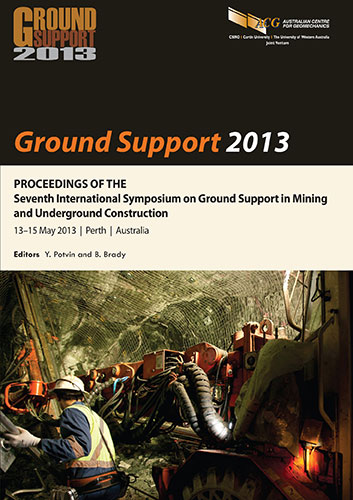Excavation curvature and roughness – their influence on the performance of mesh and mesh reinforced shotcrete

|
Authors: Windsor, CR; Roth, A Paper is not available for download Contact Us |
DOI https://doi.org/10.36487/ACG_rep/1304_23_Windsor
Cite As:
Windsor, CR & Roth, A 2013, 'Excavation curvature and roughness – their influence on the performance of mesh and mesh reinforced shotcrete', in Y Potvin & B Brady (eds), Ground Support 2013: Proceedings of the Seventh International Symposium on Ground Support in Mining and Underground Construction, Australian Centre for Geomechanics, Perth, pp. 359-372, https://doi.org/10.36487/ACG_rep/1304_23_Windsor
Abstract:
It is well known that the global geometry of an excavation is the controlling influence on the redistribution of stresses around the boundary of that excavation. The optimal shape of the excavation with respect to stress redistribution and boundary displacement will be harmonic with these anisotropic characteristics of the stress and displacement fields. The effects of local geometry, i.e. curvature and roughness, are not commonly considered. This discussion will explore the influence of excavation curvature and roughness on the installation and structural performance of surface support, constraint and retention schemes (in particular, mesh, shotcrete and their common combinations) in excavations undergoing stress redistribution and common deformation mechanisms.
References:
Windsor, C.R. (2012) The influence of excavation surface curvature and roughness on reinforcement and support practice, in Proceedings 7th International Symposium on Rock Bolting and Rock Mechanics in Mining, 30–31 May 2012, Aachen, Germany, Verlag Gluckauf GmbH, Essen, pp. 319–334.
Windsor, C.R. (1998) Structural design of shotcrete linings, in Proceedings Australian Shotcrete Conference, 9–10 October 1998, Sydney, Australia, IBC Conferences, Sydney, pp. 1–34.
© Copyright 2026, Australian Centre for Geomechanics (ACG), The University of Western Australia. All rights reserved.
View copyright/legal information
Please direct any queries or error reports to repository-acg@uwa.edu.au
View copyright/legal information
Please direct any queries or error reports to repository-acg@uwa.edu.au